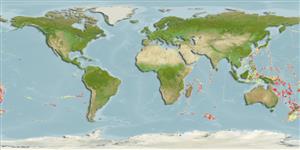>
Gadiformes (Cods) >
Macrouridae (Grenadiers or rattails)
Etymology: Ventrifossa: Latin, venter, ventris = belly + Latin, fosa = pit (Ref. 45335).
Eponymy: This fish is named after two ichthyologists Dr ‘John’ Richard Paxton (q.v.), and Dr Robert ‘Bob’ John Lavenberg (q.v.), who first recognised that it was a new species. (See Lavenberg & Paxton) (Ref. 128868), visit book page.
More on author: Iwamoto.
Environment: milieu / climate zone / depth range / distribution range
Ökologie
seewasser bathydemersal; tiefenbereich 540 - 810 m (Ref. 9949). Deep-water
Indo-Pacific: Western Indian Ocean. Western Pacific: Bismarck Sea and Papua New Guinea (Ref. 6993). Southeast Pacific: Sala y Gomez Ridge (Ref. 9949).
Size / Gewicht / Alter
Maturity: Lm ? range ? - ? cm
Max length : 47.5 cm TL Männchen/unbestimmt; (Ref. 9949)
A benthic species found on the continental slope (Ref. 75154).
Life cycle and mating behavior
Geschlechtsreife | Fortpflanzung | Ablaichen | Eier | Fecundity | Larven
Kailola, P.J., 1987. The fishes of Papua New Guinea. A revised and annotated checklist. Vol. 1. Myxinidae to Synbranchidae. Research Bulletin No. 41. Department of Fisheries and Marine Resources, Port Moresby, Papua New Guinea. 194 p. (Ref. 6993)
IUCN Rote Liste Status (Ref. 130435: Version 2024-2)
Bedrohung für Menschen
Harmless
Nutzung durch Menschen
Tools
Zusatzinformationen
Download XML
Internet Quellen
Estimates based on models
Preferred temperature (Ref.
123201): 2.3 - 9.7, mean 7.3 °C (based on 171 cells).
Phylogenetic diversity index (Ref.
82804): PD
50 = 0.5000 [Uniqueness, from 0.5 = low to 2.0 = high].
Bayesian length-weight: a=0.00575 (0.00194 - 0.01707), b=3.08 (2.83 - 3.33), in cm total length, based on LWR estimates for this (Sub)family-body shape (Ref.
93245).
Trophic level (Ref.
69278): 3.8 ±0.5 se; based on size and trophs of closest relatives
Widerstandsfähigkeit (Ref.
120179): niedrig, Verdopplung der Population dauert 4,5 - 14 Jahre. (Preliminary K or Fecundity.).
Fishing Vulnerability (Ref.
59153): Moderate vulnerability (38 of 100).
